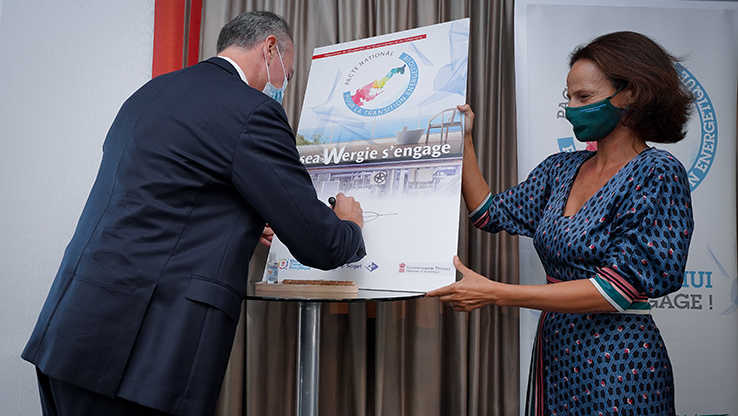Deployment of Thalassothermal Loops
Deployment of Thalassothermal Loops in the Principality in the La Condamine and Le Larvotto quarters.
Deployment of Thalassothermal Loops in the Principality in the La Condamine and Le Larvotto quarters.
A press conference was organised on Friday 22 October 2021 to provide an update on the deployment of thalassothermal loops in the Principality in the La Condamine and Le Larvotto quarters.
This meeting was held in the presence of Ms Madame Céline Caron-Dagioni, Government advisor and Minister of Public Works, the Environment and Urban Planning, and Mr Thomas Battaglione, the CEO of SMEG, representing the Monegasque seaWergie group of companies, concessionaire of the public service responsible for constructing and exploiting thalassothermal loops.
The event took place one year after execution of the concession with a presentation in the form of an update, the signature of the National Pact for the Energy Transition by seaWergie and a visit to the technical promises at the Le Larvotto loop.
For the record, energy in buildings is responsible for 35% of Monaco's greenhouse gas emissions. This is a significant number if one considers the objectives of reducing the Principality's CO2 omissions: 55% by 2030 and carbon neutrality by 2050.
This is why the Government has arranged to stop using fossil fuels to heat buildings in the Principality. By providing an alternative to fuel – which will be banned on 1 January 2022 – deployment of the two new thalassothermal loops lies at the heart of this strategy, and the State is investing over 60 million euros in it.
The deployment of the thalassothermal loops is making very significant progress.

An initial section of the La Condamine loop has already been deployed with a first building customer of seaWergie since July: Winch. The next stage is a significant one: connection to the Administration Centre, which will be completed by the end of the year. It should be noted that in Le Larvotto, the primary infrastructure for the loop has been completed, and the first sub-station supplying the buildings in the new Complexe Balnéaire in Le Larvotto has been operating since 1 July.
The concessionaire is taking action with co-owned properties and their management agents. The priority here is buildings that are currently being heated with fuel. When they are connected, these buildings will stop emitting greenhouse gases. This future solution has already attracted a number of co-owned properties, several of which have already voted in favour of connecting to the thalassothermal loop at their General Assemblies, or have even begun the transformation works. A number of property developments have also made this virtuous choice, as have major public developments (In particular the Testimonio II development) and have included this component in their plans since the design phase.
We should recall that the objective shared by seaWergie calls for connection to 29 buildings between now and 2024, targeting buildings that use fuel, thereby avoiding more than 6,000 tons of CO² a year, which is 7% of the Principality's total greenhouse gas emissions.
Finally, we should stress that the Principality is one of the first countries to develop this type of energy along its coastline. Thalassothermal loops, which are also called "marine thermal energy", consist in recovering calorific energy from the sea to supply heating and cooling to buildings. In other words, the temperature of the sea water is used to heat and cool buildings, and it has zero impact on the marine ecosystem.


